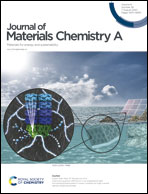Robust carbon-dot-based evaporator with an enlarged evaporation area for efficient solar steam generation†
Abstract
Solar steam generation has drawn great interest to partially remedy water crisis issues, especially in remote areas with water scarcity that have plenty of seawater (such as survival in the wild on islands surrounded by sea) by utilizing renewable solar energy to evaporate seawater. Evaporators with high evaporation rates have been widely reported recently, though efforts have rarely focused on the improvement of the mechanical properties of photo-thermal active materials with which to develop a mechanically robust and durable evaporator with high performance, thus severely limiting their widespread applications. Additionally, the effect of evaporator microstructures has not been quantitatively analyzed, which is otherwise a necessary guideline to further boost areal evaporation performance. Herein, a robust carbon dot (CD)-based evaporator was designed from the nanometer to micrometer scale by loading nano-sized CDs onto microporous substrates, which shows a high evaporation performance of up to 2.31 kg m−2 h−1 (under one sun illumination) by fully capturing solar energy and extra environmental heat. While maintaining good performance, the CD-loaded evaporator shows excellent deformation tolerance derived from strong interfacial adhesion between the CDs and cellulose, meaning that it can be bent, folded, twisted, and even sonicated without obvious damage, indicating great convenience for packing and transportation. Then, contributed to by its outstanding mechanical properties, an evaporator with a 3D structure on the millimeter scale was therefore constructed through origami, which reaches a high evaporation rate of 2.93 kg m−2 h−1 under one sun illumination. Besides this, this evaporator can be easily manufactured at low cost without needing any sophisticated preparation procedure or strict conditions, holding promise for large-scale applications and commercialization. Finally, we propose a theoretical model to simulate the effect of the microstructure on the performance of the solar evaporator in terms of the evaporation area, which is in accordance with the experimental results, providing quantitative insight for the structural engineering of solar evaporators in the future.



 Please wait while we load your content...
Please wait while we load your content...